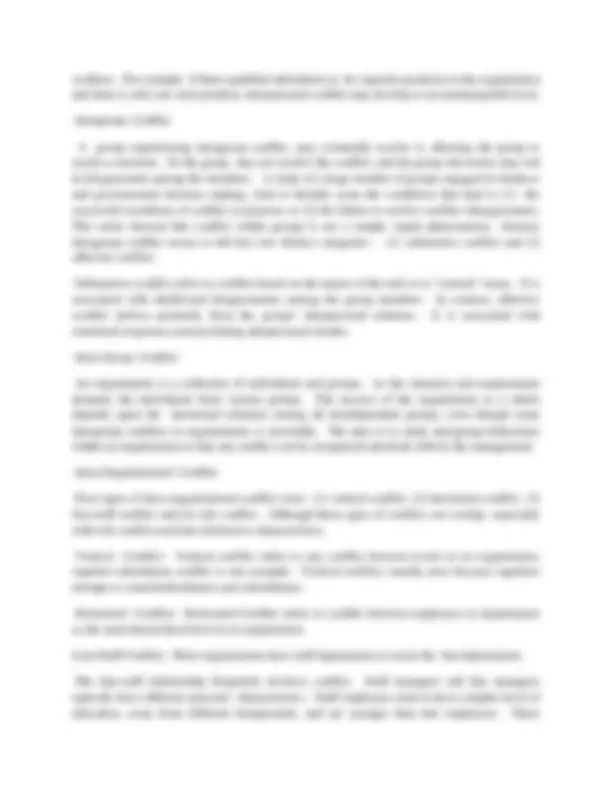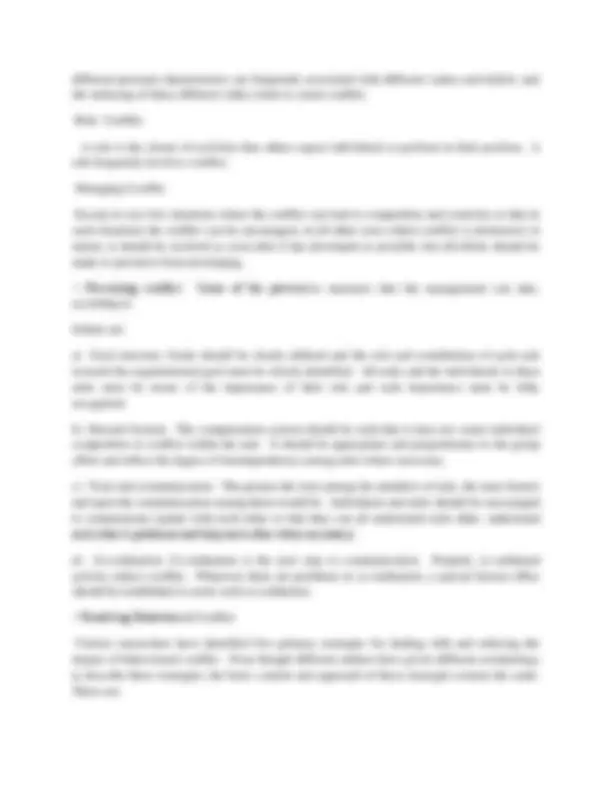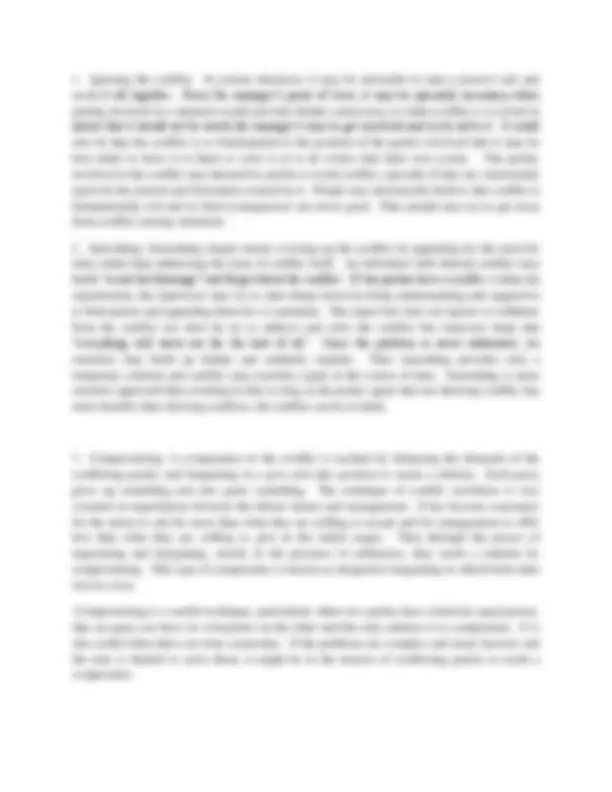





Study with the several resources on Docsity

Earn points by helping other students or get them with a premium plan


Prepare for your exams
Study with the several resources on Docsity

Earn points to download
Earn points by helping other students or get them with a premium plan
Community
Ask the community for help and clear up your study doubts
Discover the best universities in your country according to Docsity users
Free resources
Download our free guides on studying techniques, anxiety management strategies, and thesis advice from Docsity tutors
The five levels of conflict are intrapersonal (within an individual), interpersonal (between individuals), intragroup (within a group), intergroup (between ...
Typology: Study notes
1 / 6

This page cannot be seen from the preview
Don't miss anything!




Introduction To Conflict:
Conflict is difficult to define, because it occurs in many different settings. The essence of conflict seems to be disagreement, contradiction, or incompatibility. Thus, CONFLICT refers to any situation in which there are incompatible Goals, Cognitions, or Emotions within or between individuals or groups that lead to opposition or antagonistic interaction. The definition recognizes three basic types of conflict:
Goal conflict is situation in which desired end states or preferred outcomes appear to be incompatible.
Cognitive Conflict is a situation in which ideas or thoughts are inconsistent.
Affective Conflict is a situation in which feelings or emotions are incompatible; that is, people literally become angry with one another. Conflict is very common in organizational settings. This is not necessarily a negative feature; the resolution of conflict often leads to constructive problem solving.
Conflict exists in many forms other than the form that can result from competition, and managers should understand the different ways of conflict resolution. Thus examines conflict from a variety of view points. It first considers the positive and negative aspects of conflict. Next, it discusses the levels of conflict that can occur within organizations. Finally, it identifies some of the basic strategies for managing conflict.
Levels Of Conflict
The five levels of conflict are intrapersonal (within an individual), interpersonal (between individuals), intragroup (within a group), intergroup (between groups), and intraorganizational (within organizations).
Intrapersonal Conflict
Intrapersonal Conflict, which occurs within an individual, often involves some form of goal conflict or cognitive conflict. Goal conflict exists for individuals when their behaviour will result in outcomes that are mutually exclusive or have compatible elements (both positive and negative outcomes).
Interpersonal Conflict
Interpersonal conflict involves two or more individuals rather than one individual. Two managers competing for the same promotion, two executives maneuvering for a larger share of corporate capital examples of conflict between individuals are legion and quite familiar.
Reasons
a psychological problem and it has nothing to do with their job requirements or formal interactions.
different personal characteristics are frequently associated with different values and beliefs, and the surfacing of these different values tends to create conflict.
Role Conflict
A role is the cluster of activities that others expect individuals to perform in their position. A role frequently involves conflict.
Managing Conflict
Except in very few situations where the conflict can lead to competition and creativity so that in such situations the conflict can be encouraged, in all other cases where conflict is destructive in nature, it should be resolved as soon after it has developed as possible, but all efforts should be made to prevent it from developing.
Schein are:
a) Goal structure: Goals should be clearly defined and the role and contribution of each unit towards the organizational goal must be clearly identified. All units and the individuals in these units must be aware of the importance of their role and such importance must be fully recognized.
b) Reward System: The compensation system should be such that it does not create individual competition or conflict within the unit. It should be appropriate and proportionate to the group effort and reflect the degree of interdependence among units where necessary.
c) Trust and communication: The greater the trust among the members of unit, the more honest and open the communication among them would be. Individuals and units should be encouraged to communicate openly with each other so that they can all understand each other, understand each other’s problems and help each other when necessary.
d) Co-ordination: Co-ordination is the next step to communication. Properly co-ordinated activity reduce conflict. Wherever there are problems in co-ordination, a special liaison office should be established to assist such co-ordination.
Various researchers have identified five primary strategies for dealing with and reducing the impact of behavioural conflict. Even though different authors have given different terminology to describe these strategies, the basic content and approach of these strategies remain the same. These are:
Compromising is a useful technique, particularly when two parties have relatively equal power, thus no party can force its viewpoints on the other and the only solution is to compromise. It is also useful when there are time constraints. If the problems are complex and many faceted, and the time is limited to solve them, it might be in the interest of conflicting parties to reach a compromise.